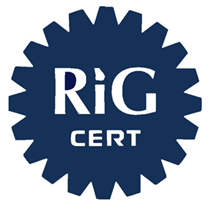ISO 14001 - Environmental management

ISO 14001 is the world’s leading standard for environmental management.
Originally published in 1996, revised in 2004 and most recently in 2015, ISO 14001 helps organizations manage their environmental responsibilities in a systematic and proactive manner.
The standard is aligned with internationally accepted principles of environmental management. It focuses on a lifecycle perspective, compliance with legal requirements, risk-based thinking, and continual improvement in environmental performance.
ISO 14001 is applicable to any organization, regardless of size, industry, or geographical location. It is widely used by manufacturers, service providers, government agencies, and non-profits looking to reduce their environmental impacts, improve resource efficiency, and enhance stakeholder trust.
RIGCERT provides accredited certification services for environmental management systems in accordance with ISO 14001. Our certification process is transparent and carried out by qualified professionals with knowledge of your sector and its environmental challenges.
Whether the goal is to reduce waste, comply with regulations, or demonstrate environmental responsibility to clients and partners, our ISO 14001 certification can help your organization make a real impact.
ISO 14001 is an international standard for environmental management.
It is applicable to any organization, regardless of size, type or how it interacts with the environment. The requirements of ISO 14001 are generic and they should be interpreted within the organization’s specific context, taking into account its environmental aspects and impacts, applicable legal obligations, and operational realities.
Support from top management
A critical success factor for an effective environmental management system (EMS) is the active leadership and commitment of top management. They are responsible for establishing an environmental policy and environmental objectives, promoting environmental responsibility throughout the organization, and ensuring that the necessary resources are allocated to implement and maintain the EMS.
Key requirements of ISO 9001
Implementing an EMS in accordance with ISO 14001 requires certain requirements established by the standard. One of the first steps is to determine and document the scope of the environmental management system, ensuring that its boundaries and applicability are well defined.
Organizations must identify and assess the environmental aspects of their activities, products, and services that they can control or influence, and determine which of these have significant environmental impacts. They must also identify compliance obligations, including legal and other requirements relevant to those aspects.
Risk-based thinking is fundamental—organizations must assess environmental risks and opportunities that could affect the intended outcomes of the EMS, including the prevention of pollution, protection of the environment, and compliance with applicable requirements.
Competence and awareness of personnel is another key element. Employees should be trained appropriately and understand how their roles impact environmental performance and contribute to the achievement of environmental objectives.
Operational planning and control must be established to ensure that significant environmental aspects are managed and that processes are performed under defined conditions. This includes implementing controls for design, development and change management, to ensure environmentally sound outcomes.
External providers—including contractors and suppliers—must be managed to ensure that their environmental impacts and obligations are properly controlled. Where environmental performance deviates from planned outcomes, the organization must take action to manage nonconformities and mitigate potential environmental harm.
Monitoring and measurement of environmental performance are essential. Organizations are expected to track key indicators, evaluate compliance, and assess progress toward the achievement of environmental objectives. Internal audits should be conducted at planned intervals to verify whether the EMS is functioning effectively and if it conforms to ISO 14001.
Regular management reviews are required to evaluate the continued suitability, adequacy, and effectiveness of the EMS, and to ensure that it remains aligned with the organization’s strategic direction.
When nonconformities occur, organizations must take corrective actions to address their root causes and prevent recurrence.
At the core of ISO 14001 is the principle of continual improvement, encouraging organizations to enhance environmental performance, reduce negative impacts, and strengthen their environmental management system over time.
The ISO 14001 Environmental Management System (EMS) certification is obtained following a successful certification audit, conducted in two stages by competent and impartial auditors.
The certification is valid for three years, during which annual surveillance audits are carried out to confirm that the organization’s EMS continues to meet the requirements of the standard.
If surveillance audits are missed or if they reveal major nonconformities that the organization does not address, the certification may be suspended or even withdrawn.
At the end of the three-year certification cycle, the organization may choose to undergo a recertification process, which is conducted under similar conditions to the initial certification cycle.
We offer accredited certification for Environmental Management Systems in accordance with ISO 14001. Our approach is tailored to the specific needs and realities of your organization, ensuring a certification process that is both relevant and efficient.
Our accreditation by ESYD, the Greek National Accreditation Body, guarantees that your ISO 14001 certificate is recognized and accepted by authorities, business partners, and other stakeholders. ESYD is a founding member of both EA (European co-operation for Accreditation) and IAF (International Accreditation Forum), which means that your certification benefits from global recognition and trust.





